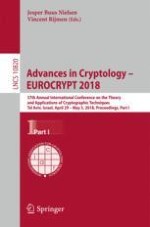2018 | OriginalPaper | Chapter
Full Indifferentiable Security of the Xor of Two or More Random Permutations Using the \(\chi ^2\) Method
Authors : Srimanta Bhattacharya, Mridul Nandi
Published in: Advances in Cryptology – EUROCRYPT 2018
Publisher: Springer International Publishing
Activate our intelligent search to find suitable subject content or patents.
Select sections of text to find matching patents with Artificial Intelligence. powered by
Select sections of text to find additional relevant content using AI-assisted search. powered by
